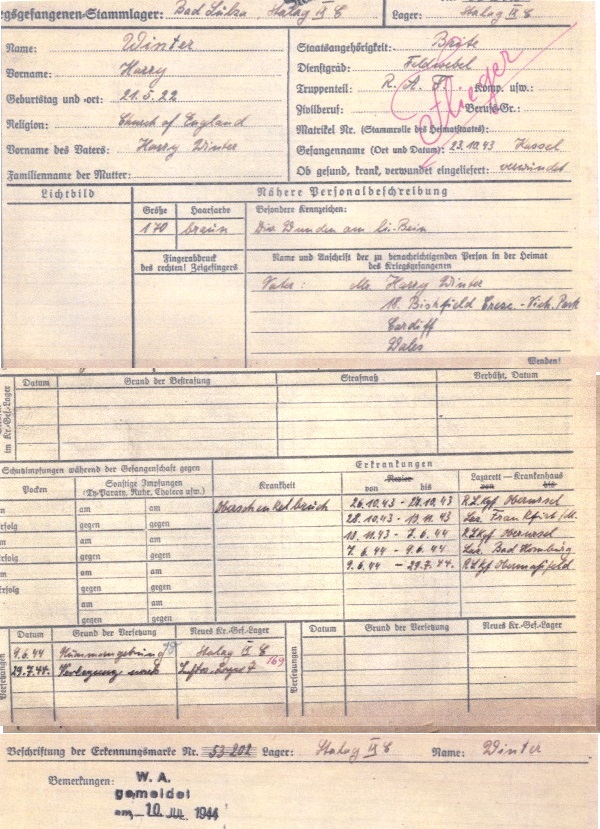Harry Winter's Story - Life as German POW
Harry joined the RAF in September, 1941 and was trained as a Sergeant Wireless Operator Air. While he was serving with 427 Squadron his aircraft was shot down on the night of 22/23 October 1943 during an operation on Kassel. He was wounded and spent time recuperating before being sent to Bankau, Poland. In January, 1945 he and fellow POWs were force marched through Czechoslovakia to south of Berlin because of Russian advances. They were liberated by Russian troops in mid April 1945.
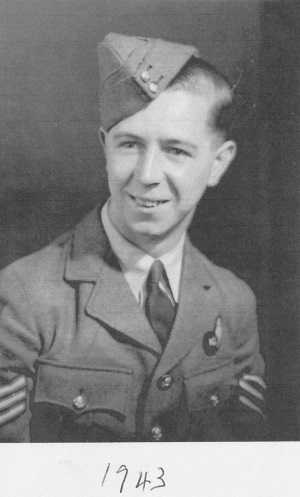
October 22, 1943
After breakfast I reported to Bob the Skipper that I was feeling fit, having reported sick three days earlier with a touch of the flu. Bob then informed us that we were scheduled for ops that night.
Briefing was immediately after lunch and we were informed that the target was Kassel and that a diversionary raid was to be made on Frankfurt. Take off time was 1730 (5:30 PM) and as the squadron was to be in the second wave of attack our ETA (estimated time of arrival) was to be set for 2104 ( 9:04 PM).
In the afternoon we had our flying supper, ham and eggs, and later transported to the dispersal.
"L" for love was the aircraft we were allocated for the trip. On arrival at the dispersal we boarded the aircraft, stowed our kit and started checking the equipment. Bob gave the signal to the fitter outside to connect the trolley, ACC (a booster to start the engine) and switched on the port inner engine. After a few attempts to start without success, we signalled by ALDIS (a lamp used for messages by code) to flight control that the engine was U/S (unserviceable). We were not allowed to use the R/T( radio telephone) because the Germans would pick it up on their listening stations. A short while later the CO (Commanding Officer) who was not flying on this Op drove over in his car and we informed him of the problem. The ground staff confirmed the trouble.
It was then established that "G" George was a spare already bombed up, so we were instructed to transfer. As the transport had returned to the MT (motor transport) section, we had to walk everything over to the other aircraft. On entering "G" we learned that no "Window" (anti-radar metallic strips) had been loaded on, so we had to do a shuttle between the aircrafts to transfer the bundles of "Window".
We took off on time occupied in our respective positions. I switched on the WT Receiver and all other equipment but unfortunately the MONICA receiver which gave warning of aircraft approaching our tail was not tuned and was oscillating, so Bob ordered it to be switched off. MONICA could only be tuned when the aircraft was on the ground. We set course for Cromer which was the rendezvous for all the Bomber force and upon reaching it all aircraft switched off their navigation lights and set course for Holland.
On reaching the Dutch coast we set course for Frankfurt. As we reached the Dutch/German border, Roy the rear guuner alerted us of a night fighter approaching our tail, giving commentary, while at the same time Tiny, the mid-uppergunner confirmed that he had the fighter in his sight. The fighter then commenced his attack, Roy ordered a corkscrew and at the same time, both gunners opened fire on the attacker. Strikes were reported on the fighter which dived into the cloud below. We then resumed course.
427 Squadron Diary Report for night of October 22/23, 1943
Just north of Frankfurt, we changed course for Kassel and as we neared our ETA, flares, followed by the TIs (target indicators) started to burst ahead. Incendiaries then started lighting up the ground. As we approached the built up area, fighter flares started bursting above us right on our track and it felt like driving down a brilliantly lit street. The fighters had been vectored onto us, as the Germans had no doubt concluded on the attack of the first wave that this was the main target.
We then commenced our bombing run under the Bomb Aimer's instructions and felt the aircraft hit as we dropped our load of high explosive cookies and incendiaries. At the end of the bombing run, when the camera had taken the photo of our bombs bursting, we turned to port and steered a course for Hanover which would be our next turning point for home.
About eight minutes from the target we were suddenly struck in the tail by cannon shells, no doubt a fighter had picked us out under the flares and followed us out. Bob said "We have been hit" and called the gunners for a report.
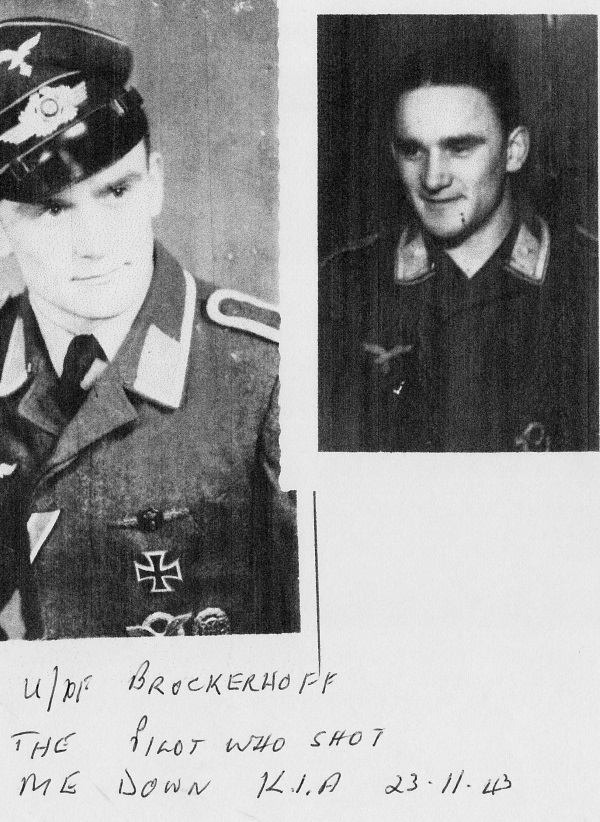
As there was no response, he requested Stan, the engineer, to go back and investigate. Stan replied that he was checking the petrol gauges for damages to the petrol tanks. Bob then requested me to go back and try to make contact. Reaching the mid-upper turret I struck Tiny on the thighs but there was no response. I then hurried to the rear turret, struck the doors and as there was no response. I endeavoured to open them at the same time looking through the porthole. The turret doors were jammed and I could see no movement or reaction from Roy. I then made my way forward and as I reached the rest position there was another burst of cannon shells coming through the fuselage. I felt a sharp sting on the inside of my right thigh and the pyrotechnics were starting to blaze. Reaching the pilot's position I indicated to Bob that there was no response from either of the gunners, at the same time I noticed that the whole of the port wing was ablaze. Bob then gave the order to bail out. I went to my position which was under the pilot's position, clipping on my parachute while Harry, the navigator, collapsed his table and chair to open the escape hatch under the chair, at the same time destroying IFF and GEE sets which had explosive charges in them. The IFF (identification friend or foe) was to distinguish us from enemy aircraft on the radar screens on our return to the UK and the GEE set was navigational aid.
The escape hatch jammed and Harry had to stamp it out to force it . I handed him a parachute, then noticed that it had my name on it. I indicated this so we quickly switched them. I then swung my legs through the hatch and the 200 mph slipstream whipped me out and as I fell away I pulled the D ring to release the parachute.
It was pitch black below and I had no feeling of movement. Suddenly I crashed into the top of a tree and fell through until my parachute got entangled and left me hanging between branches. My left thigh was numb where I had hit a branch so I placed my right foot on a branch and struck my harness release while trying to locate the branch with my left foot. Placing my weight on both feet my legs collapsed and I crashed down through the tree striking my head and losing consciousness
As I came to my senses it was getting daylight. I endeavoured to stand but had no feeling in either leg. I had landed in a small woods on a slope and could see that it was much lighter downhill than up. So I crawled to the edge of the woods.
Upon reaching the edge, I could see a man and two boys spreading something from a horse drawn cart onto the ground. Being about 20 yards away I shouted to them and when they came over, I asked for water. They lifted me to my feet but I collapsed and when I again fleetingly came to my senses knew I was being carried on a cart. I vaguely remember being taken into a building and when I finally came to I was lying on a bed with a nurse and doctor bending over me. They informed me that my left femur was broken and that I was wounded in the right thigh. Enquiring where I was the nurse stated that I was in Germany to which I replied that I had to get back to England. I endeavoured to get off the bed but my left leg was in a splint. And so my sojourn as a POW had commenced.
Hohe Mark Hospital
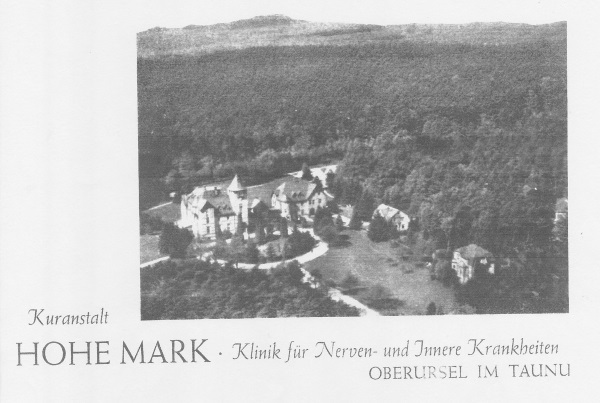
The hospital to which I was taken was run by the Sisters of Mercy in the village of Lugde which was situated approximately 10 km southwest of Hamelin. I spent the night there and the next afternoon a Luftwaffe medical orderly arrived to escort me to the Luftwaffe interrogation centre at Oberursel, 10 km north of Frankfurt-Am-Main. He was about nineteen years old and could speak little English. As I had only one escort, when the train arrived, I had to stand on one leg and be assisted by the orderly into the compartment and he then had to bring in the stretcher.
The journey by train during the night necessitated several changes, which meant repeat practice of getting on and off the stretcher. Most stations had no platforms, so I then had to sit on the carriage step and be lifted down to ground level with help. I hobbled to the station building and lay on the stretcher.
At one station I was lying quietly while the orderly was checking for the next connection when a very large and tall man walked up to the stretcher looked down at me and said in perfect English "My house in Kassel has been bombed". He was leaning on a walking stick so I felt it best not to reply. The orderly then returned and the man turned away.
When we arrived at the next changing station the orderly set me down in a small room next to the refreshment hall and brought me some noodle soup. no doubt he had to inform them for whom it was required and a constant stream of female staff came to view the enemy flyer. Some gave me a hard look, others a kindlier one
At yet a further stop I was taken into the refreshment hall which was full of mixed military and a soldier brandishing a machine pistol started raving and pointing the gun at me. The orderly quickly brought over a soldier wearing epaulets on his shoulder whom I later learned was a Sergeant. The Sergeant rapped out an order to the soldier who immediately turned away. I was very grateful to the orderly and said that maybe in the future in better circumstances, I could show my appreciation and offered him my home address of which he took note.
Furthering our journey, at another change, we met up with four aircrew who were waiting at the station for the connection. One of them was my Bomb Aimer, who informed me that when he bailed out he had lost both of his flying boots and that when captured the next day had been taken to the site of our wrecked aircraft to identify the bodies of three of the crew still in their respective positions.
The journey to Frankfurt took about eighteen hours and we finally arrived there at about eleven the following morning. There were quite a few people on the station, which had recently been badly damaged, so the orderly and the escort for the other the airmen quickly moved us to a side entrance, where a military ambulance eventually arrived to take us to the interrogation centre at Oberursel
See the Master Interrogator of Dulag Luft
where the unwounded POWs debussed and I was taken a further short distance to the hospital called Hohe Mark which was an interrogation centre for shot down airmen and a convalescent hospital for wounded German soldiers.
I was carried in and set on a single bed in a small room on the ground floor and one of the stretcher bearers speaking in a Liverpudlian accent requested me to undress and get into bed. All of my clothes were then taken away and the door was locked from outside. After a short while a Luftwaffe officer entered and stated that he was acting on behalf of the Red Cross, handed me a form headed with a Red Cross and requested that I fill in the details against the questions. Filling in my name, rank and serial number, next of kin and home address I handed the form to him. He pointed out that further questions on the form must be answered which related to my squadron base and various personnel. I informed him that the details that I had given were all that were required. He then stated that he would give me my RAF history which he then detailed correctly, giving the date and town where I volunteered, my various postings together with dates. He then informed me that he only required the completed form to confirm my identity. He then said that medical attention would now be given to me and left. Within a few minutes he returned to say that he had omitted to mention my posting to Bobbington.
Later my clothes were returned by the Liverpudlian orderly and I noted that my front collar studs and brass buttons which had been on my tunic were missing, they of course had contained small compasses issued for escape purposes. Within another short time a doctor came in and introduced himself and examined my wounds. When he had finished, two orderlies arrived, placed me on the stretcher and carried me to the next floor. I was taken to a room containing four beds, three of which were occupied. I was informed by the two orderlies that they were paratroopers who had been captured in North Africa and were both from South Wales. The occupant of the other bed was aircrew who had recently been shot down and had been operated on for bone injuries. In the conversation that followed I learned that the first floor of the building consisting of six rooms, plus a bathroom and toilet, was used entirely for allied wounded waiting surgery or having been treated were awaiting transfer to a convalescent hospital prior to their final destination, the POW camp. A German doctor was in charge with a German corporal and two German orderlies. These were assisted by a few allied personnel who had been captured earlier in the war. These consisted of the Liverpool man who was a Warrant Officer front gunner, shot down from a Manchester, an American civil pilot, who had been ferrying Catalinas across the Atlantic, and was captured after landing in the Bay of Biscay together with the two paratroopers who had been captured in North Africa. The German doctor, Dr. Ittersaghan, was an Orthopaedist who was experimenting with mending broken bones by placing a hollow metal pin inside the top half of the broken bone, pushing it up to the nearest joint then placing the broken bone together and knocking in the metal which was protruding from the joint down through the broken bone. There was then no necessity for a plaster cast.
The occupants in the various rooms consisted of two Canadians with broken femurs, two Americans with broken upper arms, an English Flight Engineer with a broken femur, a Scottish mid-upper gunner with a broken upper arm. All had recently been shot down, had had their operations and were under the observation of the doctor to note their progress.
The following day the doctor examined my leg and informed me that arrangements would be made for me to be transferred to the Herman Goering Luftwaffe Lazette in a few days where he would perform the operation on my leg and that I would be walking again very soon.
Early in November I had the operation and spent a week in the hospital before returning to Hohe Mark. Seven of us, all with similar operations, were placed together in one room, a Polish-American gunner Mike Sweck, an American waist gunner Tommy Ford from Maryland, a Canadian Bomb Aimer Bill Grant, from Fort William, a Canadian rear gunner from Waterford Ted Bowlby, a Scottish mid upper gunner Jock Little from Edinburgh, an English Flight Engineer from Ongar Jim Shelsher and myself a Welshman from Cardiff, Harry Winter.
A week later the stitches were removed and I was presented with a set of crutches and was told to start walking and as we were able to hobble about we were given little odd jobs to do, such as keeping the room clean and tidy and each afternoon after coffee we were permitted to walk around the surrounding grounds for exercise for about an hour.
Early in December the second legless pilot arrived at Hohe Mark for interrogation and medical attention. He was Colin Hodgkinson, a Spitfire pilot. Originally he had flown in the Fleet Air Arm, had been involved in a flying accident and had lost both legs, one above and one below the knee and was subsequently discharged.He then joined the RAF and while flying over France on a weather reconnaissance trip, had regained consciousness to find himself sitting in a crashed aircraft which had apparently pancaked under full power. He felt his blacking out must have been due to a lack of oxygen. He was cut and bruised when he arrived but had no serious injuries. The German orderlies were intrigued with his nightly ritual of balancing on the side of the bed and unstrapping his legs before swinging into bed.
Christmas 1943 was spent playing German gramophone records of which we had about six and the Dichter und Bauer (Poet and Peasant) was the most popular. On Christmas evening the Evangelist Sisters on the ground floor tending the German wounded came up and joined us in carol singing.
During the early part of 1944 some very badly wounded aircrew arrived and a few unfortunately did not survive. One who did was Taffy Peel who came from Newport. Apparently as he bailed out, the Lancaster went into a sideslip and one of the propellers sliced off his left arm at the elbow and his right leg at the knee. Another was Derek Salt from Birmingham. He had both legs severed below the knee. When he landed in thick snow he cut the lines of his parachute and made tourniquets until two young girls came to his assistance.
As spring approached the "Pin Boys" as the doctor termed us were getting more mobile having dispensed with crutches and finally walking sticks and Mike Sweck, feeling restricted decided that he was going for a walk but nothing had been pre planned. Having been farming in civilian life, he felt that he could live off the land. He could speak fluent Polish and felt sure that the Polish slave labour on the land would give him assistance. On one hot afternoon in early June he told the two Canadians and myself that immediately after our exercise he would be making a bid for freedom. The room windows were open and the long venetian blinds had tapes which when the blinds were rolled up would nearly reach the ground. When just we four were in the room, he went hand over hand down and dropped the last five or six feet to the ground, then ran across the grass and into the trees surrounding the hospital. As he very often laid on his bed we made it look as if it was occupied. His disappearance was unobserved for the rest of the day and at breakfast the next morning, but at mid morning while a few were seated at the table in the main central hall the English Warrant Officer hurriedly approached and demanded the whereabouts of Sweck. Glancing around the hall, someone suggested that maybe he had gone back to bed, to which we were informed that he had not. The W/O then went straight to the administration room and reported to the German corporal that Sweck had escaped. An alarm was raised and in a very short time, officers from the interrogation centre arrived and started questioning us. Dogs were brought to search the hospital ground. As we had had a thunderstorm the evening before no trace could be found.
Immediately after lunch W/O requested that the two Canadians and myself were to pack our belongings and take off our hospital dress and put on our uniforms. We were then escorted on foot to the interrogation center and put in separate cells (the cooler). Two days later one of the German ambulance drivers who had got to know us in his frequent visits to Hohe Mark came along and asked me to give him my bootlaces and braces. He spoke perfect English with an American accent. Apparently he had lived in America for some years and had come to Germany for a holiday in 1941. Hitler declared war on America and he was detained and put into the Luftwaffe. When questioned about the reason for these items, he replied that the Allies had landed on the French coast and that our hosts were taking precautions so that we would cause no further problems. A few days later I was taken out of the cooler and with the two Canadians was taken by ambulance to Bad Homburg where we met up with the other "Pin Boys" in a hospital. There we were informed that they had found Sweck who was now in the cooler and that we were all going to have our pins extracted. While waiting on the balcony outside the operating theatre, a young nurse sidled up to us to say that she was Belgian and that the Allies had landed.
With the pins withdrawn, we were returning to Hohe Mark for a short while until the stitches were removed. The two Welsh orderlies, we learned, had been sent to Luft I. We were also informed that we were being transferred to respective English and American prison camps but that Shelsher and Little would be kept there as medical orderlies. Some days later the two Canadians, myself and a few other partly recovered wounded were escorted by train to Obermasfelt, which had a larger convalescence hospital for all allied services except Americans. Here we were able to walk around the compound from dawn to dusk. There was an area outside the compound where football could be played on a Saturday afternoon for all soldiers but not fliers.
Stalag Luft VII
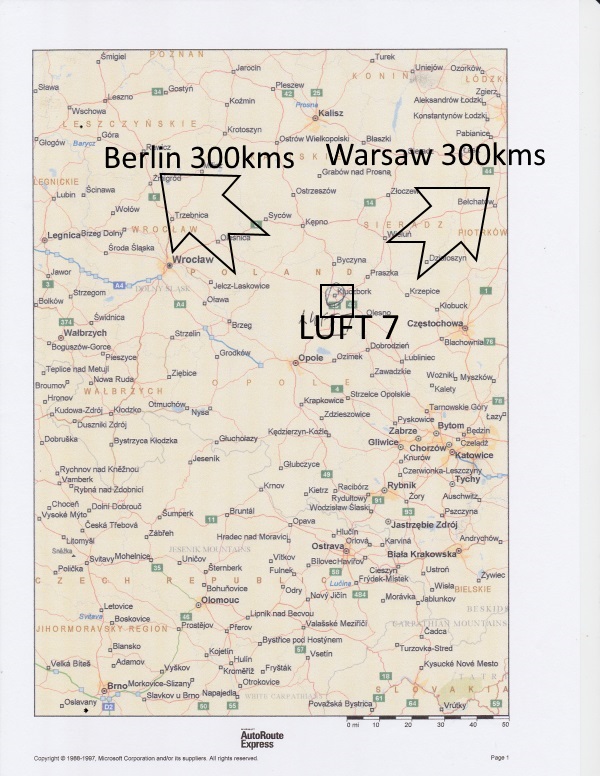
Mid July saw a small party of RAF personnel escorted by two guards armed with a handgun each entrain for Stalag Luft VII in Upper Silesia. The first part of the journey was by passenger train where we were put in a carriage together with civilians who were made up of women and children. We had been issued with a Red Cross food parcel each for travelling so we extracted the chocolate and offered it to the children. They were reluctant to take it until their mothers, recognizing what it was, permitted them to accept. We then lit up cigarettes showing off packets of 20 American brands. German civilian men were only allowed three cigarettes a day and the women none.
Just before noon there was an air raid alarm and a lot of B-17s and B-24s passed overhead. Our first change of trains was at Erfurt which unfortunately had just sounded the all clear after being visited by the bombers. Our guards seeing the chaos on and around the station, moved us to the end of the platform where we tried to look inconspicuous but a civilian with a swastika on his lapel had spotted us and started inciting the people around to hang us as"terror fleigers". Fortunately a goods train with open covered wagons full of German troops had just halted and our guard asked to which town they were next heading. When informed Leipsieg we were ordered to jump aboard which we did very smartly. We learned from the troops that they were heading for the Russian front. We reached Leipsieg after dark where again we had to change trains. Here we hid behind the stacks of rubble until our connection came in.
Our next change was at Dresden which we reached in the early daylight hours. At that time Dresden was untouched. One of the guards found us a room in a platform basement where we were able to refresh ourselves and eat before getting down to sleep. In the afternoon we boarded another train bound for Breslau which we reached about midnight. We then had to walk from the west to the east of Breslau to catch another train to Bankau, which we finally reached in the early daylight hours. The camp was about a two miles walk and we arrived before the camp administration had arrived, so we had to sit on the grass outside until they arrived to sign our receipt and receive our documents. We were then taken up to the gates of the camp where the inmates were waiting to welcome us.
The camp was new having been opened a few weeks earlier and only about fifty men were held there. The camp had been very hurriedly built and consisted of a guard room and a cookhouse which were about normal dimension but the huts for the prisoner accommodation were only fourteen feet long, nine feet wide and seven feet high at the apex of the roof and they were to sleep six men. A small two foot square table and a stool for each man was provided but no beds just a wood shave filled sack for each to sleep on. At night the stools were stacked on the table in the corner. There was no lighting provided so oil lamps had to be made from small fish paste tins filled with margerine and a wick made with string or pyjama cord. One blanket, a horse-hair filled sack for a pillow, a china mug and a spoon to each man. We were photographed and our records updated then we were passed into the main compound. Here we were met by an Australian Sergeant pilot who introduced himself as the Camp Commander, Peter Thompson. After his taking our details at his office we were allocated our accommodation. The weather was at that time very warm and the only means of keeping fairly clean was by stripping, standing under the only hand water pump and having someone pump the handle. A new compound had just been wired off next to ours and a labour force of Russian POWs were building larger huts which we would move into when they were finished. The new huts had electric lighting, a heating stove and also shower blocks. They were to be ready by late autumn.
The cook house was staffed by "Kriegies", POWs, and provided one meal a day supplied by the Germans. This consisted of three, one inch diameter frost bitten potatoes considered unfit for consumption by our captors and a cup of ertzatz coffee made from acorns. Anything further was provided by the Red Cross parcels. Once a week we were allocated a few ounces of pulped stinking fish and soft pulped cheese which would only be eaten if there was a food parcel shortage which happened more often as time went by. We also had a ration of pulped sugar beet which they termed as jam which most of us could n0t stomach. Being a new camp, buffer stocks of food parcels had not been accumulated so each week we eagerly awaited the arrival of a further consignment. All administration of the camp was done by us and supervised by the Germans. But for the two roll calls per day we were left very much alone. The next few months were spent organizing sport days and making "blowers". These were used for cooking the food from the Red Cross parcels. The cans which came from the meat and vegetable tins were made into short pipes. The pipes had a belt driven fan at one end and a square plate at the other which had a square inch hole cut in the centre. This contraption, all encased in wood which was acquired from the wooden cases in which the food parcels had been packed. The cases were cut up and distributed to handy men who had DIY skills. Fuel was acquired from the cardboard parcel boxes. Nothing was wasted
All tins of food were punctured before the parcels were distributed so things like salmon, fish paste, sardines and meat paste which deteriorated quickly had to be eaten first. Generally, we organized ourselves into groups of six so that by combining the contents of the parcels each day six small tins of powdered eggs and the same of bacon could be made into one meal for all six or six tins of sardines could be shared. Also the bread which was made from sawdust was allocated to perhaps one loaf per hut per day so this was shared accordingly.
At the end of October we were transferred to the adjoining compound where the buildings were about twenty feet high,sixty feet long and about twenty feet wide set on stilts. They were built on stilts to stop us digging tunnels under our rooms. Inside they were sectioned off into rooms each side of a central corridor, with each room containing eight two tier bunks. A table was supplied, a round iron stove and a low wattage light bulb. Next to the cook house a room was provided which was turned into a theatre and next to that another room for studies. There was also a shower block with cold water which could be used at any time and we were allowed a hot shower once a week, two minutes each.
At about this time Peter Thompson was notified of his commission being established.
Autumn quickly turned to winter giving lots of snow. An ice rink was made with packed snow but very few skates could be obtained from the Red Cross. A gramophone arrived with a few records so each room borrowed it in turn. Musical instruments began arriving. A piano was acquired and as there were a few musicians now in the camp a band was made up.
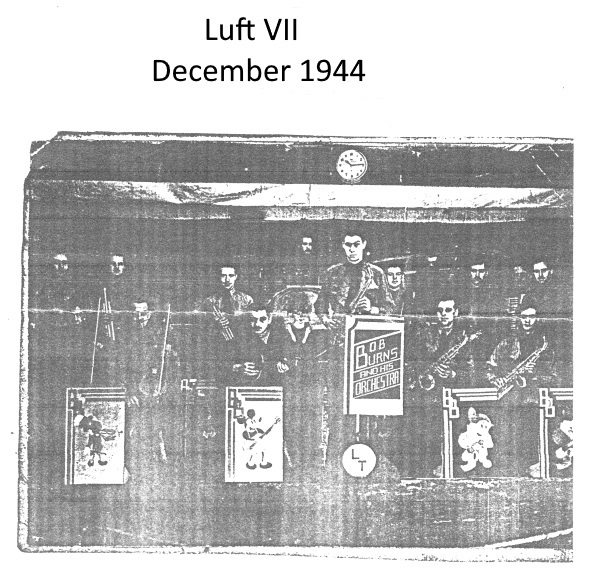
Bandstands were made from the tea chests in which the Red Cross parcels had been packed and as we also had a few budding actors, various entertainments were organized. For Christmas a pantomime was organized together with one of Noel Coward's plays called "The Red Peppers".
Unfortunately the supply of Red Cross food parcels dried up so each week our allocation diminished first to a parcel between two and then finally by Christmas one between four.
Various study groups had also been formed and classes for example were formed to learn languages. The Welsh boys had a weekly get together with various subjects discussed and we had contact with some Welsh newspapers to which we made reports of our activities.
Christmas 1944 was spent with services in the different religions and the Christmas Feast was made up of bits and pieces which had been hoarded for the occasion.
Early in January 1945 the rumble of guns could be heard from the east and with the daily news from "The Canary", the forbidden radio receiver which had been smuggled into the camp, speculation was rife that there was a possibility that the Russians would be arriving in the very near future. But our hopes were dashed by a rumour that we were to be evacuated and marched to the west. The rumour unfortunately proved correct and on January 19, 1945 the order came through.
Detailed Report on the Long March Click here
Detraining in the early hours of the morning we were marched about two kilometers to a prison camp, Stalag IIIa, at Lukenwalde. Having been in a cramped position for three days it was an effort to get the circulation working. Immediately when we arrived at the camp we were allocated barrack blocks with no beds but a little straw spread on the stone floor. We were then paraded to receive a few boiled black potatoes in their jackets and ertzatz tea made from dried mint. The effect of the hot dirty potatoes gave most of us dysentry. As there was no lighting in the barrack block and men were sleeping at all sorts of angles there was a lot of chaos, accidents and squabbling as in their panic to get to the outside lavatories men were falling over each other in the pitch darkness. Very few food parcels arrived, the Germans putting out a report that due to the bombings, the consignments were being held up. It was reported by POWs soldiers out on working parties that they had witnessed the parcels being off loaded at the goods yards and distributed to the German people so our food ration was minimal. The camp was overcrowded with evacuees from surrounding camps and of all nationalities. Everyone was infested with lice so it was a ritual every morning to take our blankets outside in the freezing air and hang them on makeshift lines usually made of barbed wire which separated the compounds to try to kill them off. Then we would run a flaming taper of straw along the seams of our shirts to further get rid of them.
The end of March, 1945 brought warmer weather and again the sound of guns so morale started picking up. "The Canary " also come back to life so we had daily bulletins of the advance from the West.
Freedom at Last
One Saturday in the middle of April the Germans moved out of the camp, ordering us not to break out as an SS company was situated in the nearby woods and that if we endeavoured to leave we would be fired on. During the night aircraft were flying overhead and the camp was straffed but there were no reports of casualties
Early on the Sunday morning lookouts saw tanks approaching and they slowly drove up to the wire. The whole of the camp was by then aroused and the tanks having established who we were started rolling along the barbed wire perimeter tearing it down. Russian officers then came in, located the Russian compound, gathered their fellow countrymen together and ordered them to join the advancing army which they did. An invitation was extended to other nationals to accompany them but this was politely declined. We were then informed that we were free to go into town to forage for food and await developments but on no account to attempt to go west. During the next week we had a first class view of the "Battle of Berlin" by day and at night the sky in the west was lit up with the flashes of the guns of the advancing Russians and Americans.
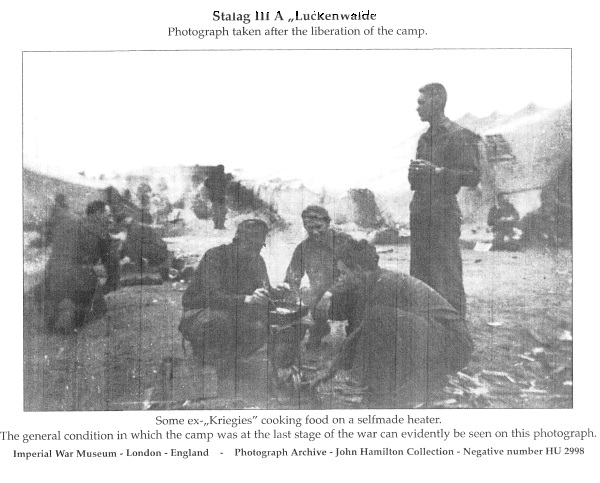
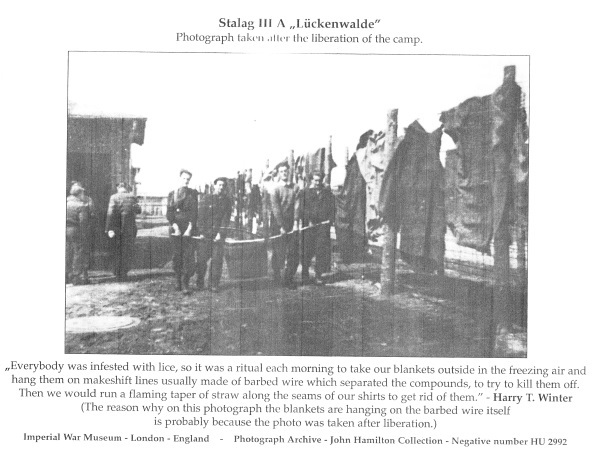
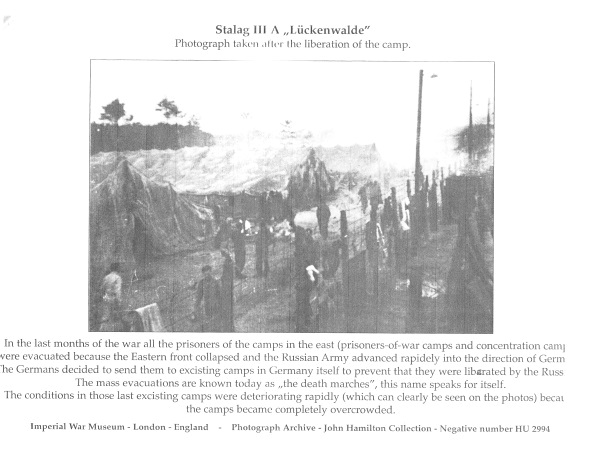
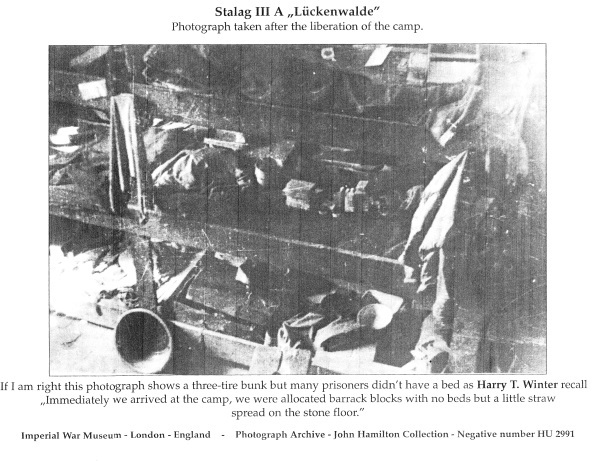
Letter of Senior Allied Officer Click here
The next day information was spread that a transport was hidden in a small wood just south of the camp and that small parties should make their way there. When the truck was filled they would whisk their load to the west, but stationing another empty truck in its place. This arrangement was duly carried out and I together with many more crossed the Elbe on May 8, 1945 into American hands at Schonebeck. A report later came through that the Russians discovering the evasion route brought out tanks and threatened that further transport attempts would be dangerous. They then blew up the pontoon bridge across the Elbe. The remainder of the Luckenwalde inmates who missed the American truck transport were eventually repatriated but via Odessa, on the Black Sea, a distance of one thousand miles south west from Stalg IIIA.
Those of us who had managed to get out with the American trucks,on the next day were transported again by truck to Hildesheim where we were deloused and then spent the night there with some entertainment laid on for us. The next morning we were flown by a Dakota (DC3) to Brussels where we were again deloused and given clean battle dress, handed a few francs and told to go into town for a few hours. On our return we were instructed to pack our few belongings and were transported to the railway station where we boarded a passenger train which had been transformed to carry enemy POWs. We spent the night travelling to Lille where Lancasters flew in at the airfield and we were transported across the channel finally landing at Dunsfold in Surrey. A short journey by road to Guil
ford, up to London for lunch, another train to Cosford for a medical and the next day being fully kitted out and sent home on leave.
Harry's German POW Record
